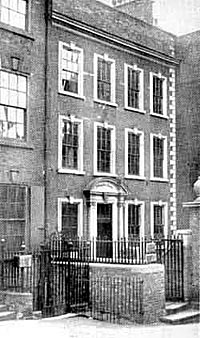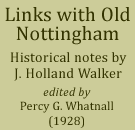< Previous | Contents | Next >
Willoughby House, Low Pavement
 |
THIS beautiful house was built sometime between 1730 and 1740 by the Right Honourable Rothwell Willoughby, brother of Lord Middleton, the then owner at Wollaton Hall, and is therefore about contemporary with the first appearance of the Methodists in London.
Almost directly after the Civil War the first Duke of Newcastle commenced to build a magnificent palace which we know as Nottingham Castle upon the site of the mediaeval fortress on the summit of the castle rock. He did not live to see its completion in 1671, but it was occupied in great state by his immediate descendants.
Attracted by the glamour and social life of this ducal court many gentry built houses for themselves in Nottingham, in order that they might participate in the genteel recreations centring round Nottingham Castle, and that is why Nottingham is rich in beautiful eighteenth century houses.
Willoughby House is one of these. Rothwell Willoughby was a wealthy and popular bachelor, and it is interesting to remember that he kept a pack of hounds, largely for the benefit of the townspeople of Nottingham.
The house itself is as beautiful inside as it is outside ; behind it is a pleasant and well preserved garden, and it stands upon what is believed to be the finest set of rock cellars in Nottingham.
It is well to notice the parapet that fronts Low Pavement. In bygone days the view from the roof of a house was regarded as an asset, and easy access to the lead-covered portions of the roof was usually arranged by means of staircases.
Readers of Samuel Pepys’ diary will remember his constant reference to evenings spent talking and singing on "the leads." To prevent accidents, parapets were erected, of which the one surmounting Willoughby House is an excellent example.
